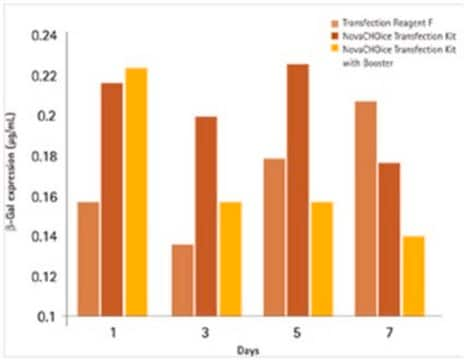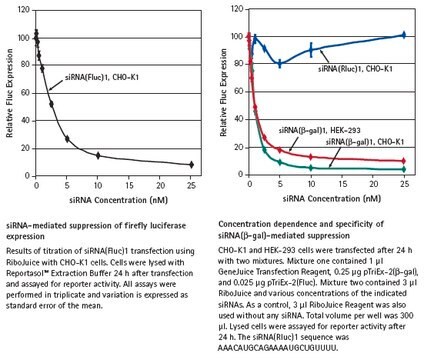L3287
Escort™ IV Transfection Reagent
Lipid reagent for transient and stable transfection of mammalian and insect cells.
Sinonimo/i:
Gene delivery
About This Item
Prodotti consigliati
Grado
for molecular biology
Livello qualitativo
Forma fisica
liquid (aqueous solution)
impiego
1 mL sufficient for 160-500 transfections
Concentrazione
1 mg/mL
tecniche
transfection: suitable
Temperatura di conservazione
2-8°C
Categorie correlate
Descrizione generale
Applicazioni
Caratteristiche e vantaggi
- Suitable for stable and transient transfection
- Optimized for a wide variety of cell lines
- Low toxicity
- Compatible with both serum and serum-free transfection protocols
- Ideal for Sf9, Sf21 and S2 insect cells
Componenti
1 mg/mL total lipid in water
Note the identity of the lipids used in Escort™ IV is confidential.
Avvertenza
Principio
Note legali
Prodotti correlati
Codice della classe di stoccaggio
10 - Combustible liquids
Classe di pericolosità dell'acqua (WGK)
WGK 3
Punto d’infiammabilità (°F)
Not applicable
Punto d’infiammabilità (°C)
Not applicable
Dispositivi di protezione individuale
Eyeshields, Gloves
Certificati d'analisi (COA)
Cerca il Certificati d'analisi (COA) digitando il numero di lotto/batch corrispondente. I numeri di lotto o di batch sono stampati sull'etichetta dei prodotti dopo la parola ‘Lotto’ o ‘Batch’.
Possiedi già questo prodotto?
I documenti relativi ai prodotti acquistati recentemente sono disponibili nell’Archivio dei documenti.
I clienti hanno visto anche
Articoli
Transfection introduces genetic material into cells, aiding research in gene expression and cell biology.
This brief webinar provides an overview of what transfection is and the methods that are used to introduce DNA or RNA into eukaryotic cells.
Protocolli
The product bulletin providin detailed use protocol for easy DNA transfection.
Product manual provides detailed protocol for easy DNA transfection.
Universal Transfection Reagent enables efficient nucleic acid delivery into various cells, compatible with different cell culture conditions.
Calcium phosphate transfection is a common method for the introduction of DNA into eukaryotic cells. This protocol can be optimized for use with a wide variety of cell types.
Contenuto correlato
Browse our convenient transfection reagent selection guide to match the best reagent for your specific cell line and application needs.
Il team dei nostri ricercatori vanta grande esperienza in tutte le aree della ricerca quali Life Science, scienza dei materiali, sintesi chimica, cromatografia, discipline analitiche, ecc..
Contatta l'Assistenza Tecnica.











